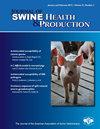Evidence of improved reporting of swine vaccination trials in the post-REFLECT statement publication period
IF 0.7
4区 农林科学
Q3 Agricultural and Biological Sciences
引用次数: 18
Abstract
Objectives: Describe and compare the proportion of studies reporting the method used to assign study units to treatment groups, reporting a random allocation approach, reporting 18 REFLECT items, and the proportion of studies having a low risk-of-bias assessment in swine vaccination trial studies published after the REFLECT statement, compared to studies published before. Materials and Methods: The study population was 61 studies that evaluated vaccines targeted at pathogens affecting swine health or pork safety. Two reviewers assessed the reporting of 18 of 22 REFLECT items and 5 risk-of-bias domains. Results: Authors reported the method used to allocate experimental units in 33 of 42 (79%) and 14 of 19 (74%) studies published prior to and following REFLECT, respectively. There has been a substantial shift in the reporting of allocation approaches. Before 2011, only 2 of 25 (8%) studies that reported using random allocation provided supporting evidence. This increased in studies published between 2011-2017 (4 of 6; 66%). Before 2011, 8 of 33 (24%) studies reported using systematic allocation, which increased to 43% (6 of 14 studies) between 2011-2017. There has also been an increase in the prevalence of reporting for 14 of the 18 REFLECT items. There was an increase in the number of studies reporting evidence to support true randomization to group and data that suggests few baseline imbalances. Implications: Data from this study suggests swine vaccination trial reporting improved, which may be due to researchers having more access to better quality information.在后reflect声明发布期改进猪疫苗接种试验报告的证据
目的:描述和比较报告了将研究单位分配到治疗组的方法、报告了随机分配方法、报告了18个REFLECT项目的研究的比例,以及在REFLECT声明之后发表的猪疫苗接种试验研究中进行低偏倚风险评估的研究的比例,与之前发表的研究相比。材料和方法:研究对象为61项针对影响猪健康或猪肉安全的病原体评估疫苗的研究。两名审稿人评估了22个REFLECT项目中的18个和5个偏倚风险域的报告。结果:作者报告了在REFLECT之前和之后发表的42篇研究中有33篇(79%)和19篇研究中有14篇(74%)分别使用了分配实验单元的方法。在报告分配办法方面有了重大转变。在2011年之前,25个报告使用随机分配的研究中只有2个(8%)提供了支持性证据。在2011-2017年间发表的研究中,这一比例有所增加(6项中的4项;66%)。2011年之前,33项研究中有8项(24%)报告使用了系统分配,2011-2017年期间增加到43%(14项研究中有6项)。在18个REFLECT项目中,有14个项目的报告普及率也有所提高。有越来越多的研究报告证据支持真正的随机分组,数据表明基线不平衡很少。启示:本研究的数据表明,猪疫苗接种试验报告有所改善,这可能是由于研究人员有更多的机会获得更高质量的信息。
本文章由计算机程序翻译,如有差异,请以英文原文为准。
求助全文
约1分钟内获得全文
求助全文
来源期刊
CiteScore
1.80
自引率
0.00%
发文量
29
审稿时长
>36 weeks
期刊介绍:
The Journal of Swine Health & Production (JSHAP) is an open-access and peer-reviewed journal published by the American Association of Swine Veterinarians (AASV) since 1993. The aim of the journal is the timely publication of peer-reviewed papers with a scope that encompasses the many domains of applied swine health and production, including the diagnosis, treatment, management, prevention and eradication of swine diseases, welfare & behavior, nutrition, public health, epidemiology, food safety, biosecurity, pharmaceuticals, antimicrobial use and resistance, reproduction, growth, systems flow, economics, and facility design. The journal provides a platform for researchers, veterinary practitioners, academics, and students to share their work with an international audience. The journal publishes information that contains an applied and practical focus and presents scientific information that is accessible to the busy veterinary practitioner as well as to the research and academic community. Hence, manuscripts with an applied focus are considered for publication, and the journal publishes original research, brief communications, case reports/series, literature reviews, commentaries, diagnostic notes, production tools, and practice tips. All manuscripts submitted to the Journal of Swine Health & Production are peer-reviewed.

 求助内容:
求助内容: 应助结果提醒方式:
应助结果提醒方式:


